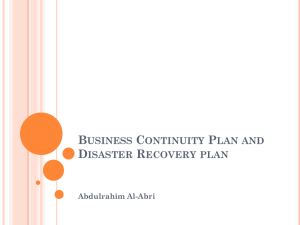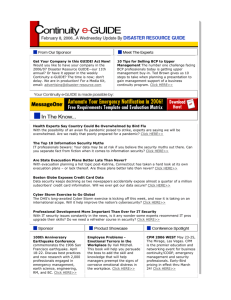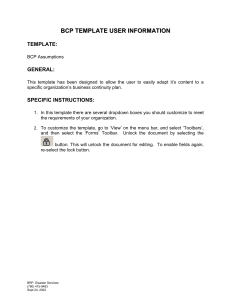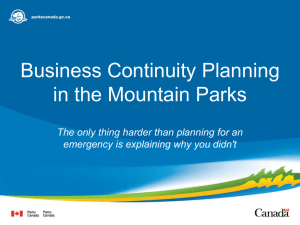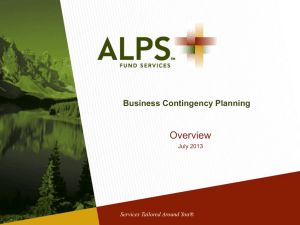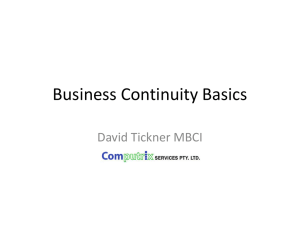Crisis Management/ Business Continuity
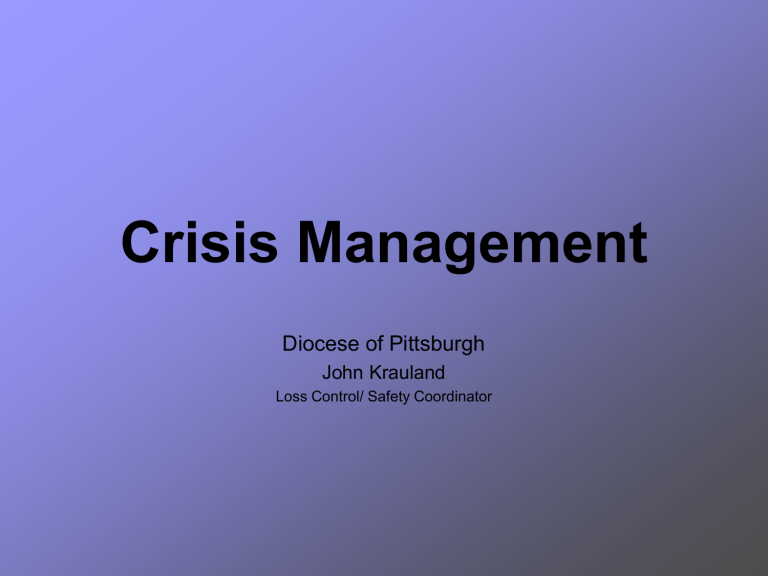
Crisis Management
Diocese of Pittsburgh
John Krauland
Loss Control/ Safety Coordinator
Crisis Management
• Crisis Management is the process by which an organization deals with a major event that threatens it’s operation.
• It involves dealing with the threats:
– Before
– During, and
– After
• Consideration should be given to both perception and reality.
Examples of Crises
Natural disasters (flood, tornado, earthquake)
Severe weather
Fires
Hazardous material spills
Bus crashes
School shootings
Bomb threats
Medical emergencies
Student or staff deaths
Outbreaks of disease or infections
Process of Crisis Management
Prevention – addresses what can be done to eliminate or reduce the risk to life, property, and efficacy.
Preparedness – focuses on planning for the worstcase scenario.
Response – is the steps taken during a crisis
Recovery – returning back to “normal”
Establish a Committee
A “Safe n’ Secure” committee should be established to identify roles and responsibilities within the crisis management cycle.
“If you fail to plan, you plan to fail.”
Crisis Planning should…
Begin at the top.
Not be done in a vacuum.
Open lines of communication.
Include police, firemen, and EMS.
Establish a common vocabulary.
Include all facilities.
Provide direction.
Mitigation and Prevention
Phase 1
Keys to Preventing a Crisis
• Facility location/ layout
• Property maintenance
• Security procedures
• Life safety compliance
• Community involvement
• Timely response to incidents
Facility Location/ Layout
Keep in mind:
Geography
Building uses
Parking lots
Playgrounds
Occupants
Property Maintenance
• Buildings
• Grounds
• Systems
• Vehicles
Security Procedures
• Access controls
– Entry
– Alarms
• Visitor protocol
• Early dismissals
• Discipline/ Prosecution Policies
Life Safety Compliance
• Means of egress
– Paths or isles
– Doors/ exits
– Locks
• Emergency lighting
• Contents/ storage
• Protective systems
Community Involvement
• Use the resources available to you:
– Parishioners
– Fire, Police, and EMS
– Community leaders
– Local emergency management directors
• Consider a “suggestion box”
• Social development programs
Timely Response
Every incident is not a crisis.
Don’t let it become one.
Preparedness
Phase 2
The following elements should be considered:
• Site security
• Emergency action plan
• Business continuity plan
Security Measures
Outside Recommendations:
Clearly define property
Clearly label facilities
Maintain adequate lighting
Limit blind spots
Remove items to scale buildings
Routinely inspect the premises
Security Measures
Inside Recommendations:
Limit the use of entrances
Institute strict procedures for key control
Secure access points of joint-use facilities
Routinely inspect doors and windows
Keep unoccupied areas locked
Keep door latches in the locked position
Security Measures
Considerations specifically for schools:
Install a panic alarm in main office area
Ensure all classrooms have 2-way communication
Use caller ID
Ensure radio frequency communication is possible
Restrict access to all mechanical/ utility rooms
Implement student release procedures
Develop an
Emergency Action Plan
(EAP)
EAP
An EAP is a proactive plan to deal with potential threats, so that everyone knows what is expected of them when something happens. The major elements are:
•Hazard assessment
•Resource assessment
•Responsibility assessment
•Communication assessment
•Policy and Procedures
•Training and education
•Record keeping
Hazard Assessment
Identify hazards, assess risks. Determine:
– the types of hazards (fire, flooding, tornado, etc.).
– the probability of their occurrence.
– the extent of damage if hazards occur.
Resource Assessment
Assess capabilities and resources.
– What do we have?
– What will we need?
– Identify personnel and equipment.
Review existing plans if they exist.
Responsibility Assessment
For each hazard or threat, determine who is responsible for necessary actions.
Keep in mind, one person can not be everywhere at the same time all the time.
Be detailed and precise when assigning responsibilities to personnel.
Communication Assessment
Who do you need to communicate with?
Administration
Families
Authorities
Utility providers
Mutual-aid providers
Media
What ways do you communicate?
Phones, Email, Radios, PA Systems
When is communication necessary?
Develop Procedures
Using the information you’ve gathered through the multiple assessments, develop the procedures to be followed for each threat.
Include drawings with evacuation plans, utility shut-offs, safety equipment, etc.
Write It!
Put the plan in writing. The easiest way to get everyone on the same page is to give them the same book.
Implement & Practice the Plan
Give all employees a copy of the plan and train them on their responsibilities within the plan.
Invite local authorities to review your plan.
Practice the plan. Identify weaknesses.
Types of Drills
• Evacuation
• Lock-down
• Table top scenarios
• Bus evacuation
Update the Plan
No matter how specific your plan, it is likely that once practiced, changes will need to be made. Make the changes in the written plan and communicate the changes with everyone they affect.
Develop a
Business Continuity Plan
(BCP)
Business Continuity Plan (BCP)
Business continuity planning focuses on sustaining the delivery of services essential to the organization’s survival.
•Personnel
•Bank accounts
•Vendors
•Property
What should be included in a BCP?
A BCP should identify:
• What services you deliver,
• To whom these services are delivered,
• Who will deliver the services, and
• Alternate locations the services will be offered
The more detailed you are now, the easier the recovery process will be later.
Response
Phase 3
Assess the Situation
Does a crisis exist? If so, determine:
• The type of crisis
• The location
• The magnitude
Notify Emergency Responders
• Don’t delay!
• It is never too early.
• Give as much information as possible
Alert key personnel for your facility.
React
• Respond within seconds
• Evacuate or lock down facility
• Triage injuries if necessary
• Trust the leadership
• Communicate appropriate information
Document, Document, Document
• Record all actions taken
• Record damages
• Record financial transactions
• Keep all original notes and records
Recovery
Phase 4
Return to “Normal”
• Take as much time as needed
• Focus on people and buildings
• Continue communication
• Provide for families, staff, and responders
Evaluate Response Activity
Evaluation of the response can help guide the prevention and planning processes for the future.
• What worked and what didn’t?
• What additional training is necessary?
• What additional resources are necessary?
Questions
Helpful Links and References
•
John Krauland – Loss Control/ Safety Coordinator
Office: 412-456-3150 Email:jkrauland@diopitt.org
• Catholic School Safety and Security Manual
•
Parish Emergency Action Plan Guide http://www.diopitt.org/pdfs/parish-emergency-action-plan-guide
•
Practical Information on Crisis Planning http://www2.ed.gov/admins/lead/safety/emergencyplan/crisisplanning.pdf
• Department of Homeland Security – School Safety http://www.dhs.gov/school-safety
• Mitigating Hazards in School Facilities http://www.ncef.org/pubs/pubs_html.cfm?abstract=mitigating2
• Department of Homeland Security – Active Shooter Booklet http://www.dhs.gov/xlibrary/assets/active_shooter_booklet.pdf
•
Church Mutual – Self-Inspection Safety Checklist http://www.churchmutual.com/admin/store/downloads/Self_Inspection_Checklist.pdf
•
Church Mutual – Free Safety Resources http://www.churchmutual.com/index.php/choice/risk/page/intro/id/21
